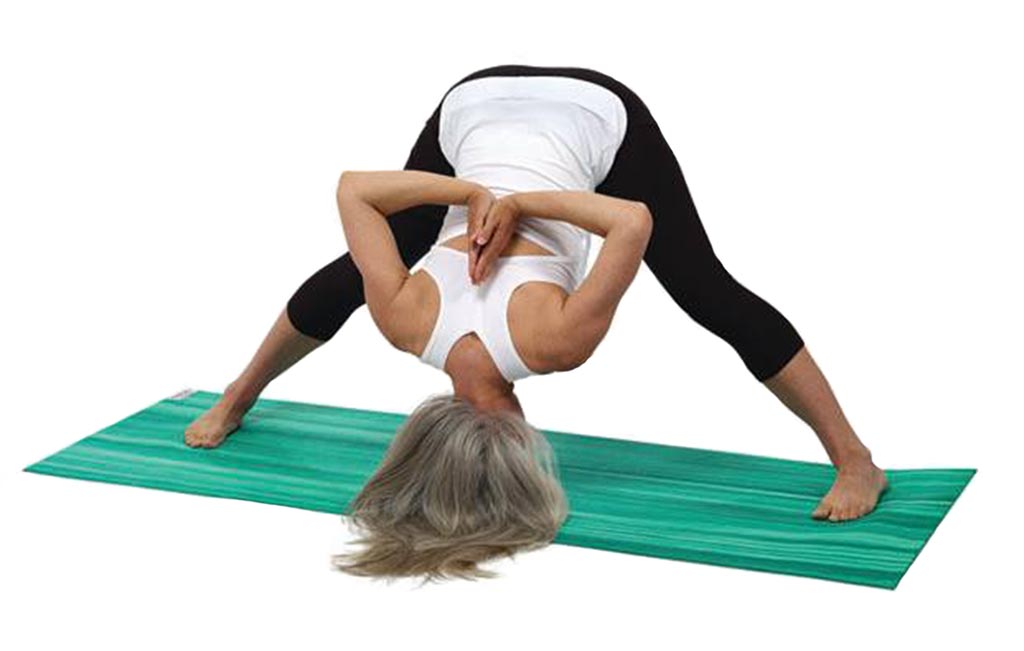
Our limbs include not only our arms and legs, but also the tailbone and the head. Way back at a time few of us remember, all our nutrients came to us through our navels and then radiated out to all our limbs. Through the umbilical cord, we took in nourishment and oxygen that was then distributed to the outlying areas of our bodies. For our first six months or so outside the womb, our bodies imitated this starfish-like breathing pattern, termed navel radiation. Navel radiation helped us unfurl our limbs so that we could begin to move about the world.
Navel radiation is a pattern that can help us open freely into yoga poses even as adults. By freeing the belly for abdominal-based breathing, we can then intentionally extend the breath energy out into all our limbs. Freeing the belly is key. Your torso—chest and abdomen—are the intersection between the arms, legs, head and tailbone. When we chronically suck in our bellies, that intersection becomes blocked, inhibiting the flow of energy among the limbs. Prasarita Padottanasana (Wide-Legged Forward Bend), like all standing poses, expresses navel radiation simply through its shape, making it easy to explore this vital breathing pattern.
Prasarita Padottanasana is one of yoga’s symmetrical standing poses. As such, it’s generally easy on the sacroiliac (SI) joint, especially when you practice with the intention of moving the pelvis and the spine together. Because of the wide stance, the SI joint will only be overstretched—and possibly compromised—if you bend from the waist. So make sure you have some yoga blocks handy as you begin to practice this pose.
How to Practice Prasarita Padottanasana
- Begin by standing on a nonskid mat with your feet hips-width apart. Jump or step your feet out to a wide stance, about a leg-length apart. If you extend your arms straight out to the sides from your shoulders, your feet should be directly below your hands.
- Plant your feet into the ground, feeling the footprint you are making on your mat. Are the inner and outer heels and balls of your feet planted evenly? If not, chances are you may feel the weight sagging into your inner feet. Allow the muscles and skin of your outer legs to stream down along your bones from your hips to your outer feet to help you root the feet more evenly.
- Raise your arms up to a “Y” position (think “YMCA”—the song). Relax your abdomen and chest, and breathe deeply into it. Imagine sending your inhalation from your center up and down the spine to the head and tailbone. When you feel the connection between head and tailbone, begin to explore sending the inhalation out into your limbs, all the way to the fingers and toes. Allow your body to settle on each exhalation. Take 5 to 10 breaths.
- Release your arms and place your hands on your hips. Bending from the pelvis, let your torso come forward as far as it will go without feeling your breathing become restricted. Place your hands on the floor if they will reach, on yoga blocks, or on the seat of a chair. Again, explore navel radiation first from head to tailbone, then moving the breath out into all the limbs. Stay for 5 or 10 deep breaths. If you can’t feel the breath radiating outward, you are probably pushing too far.
- If you want to stretch your shoulders and chest, you can clasp your fingers behind your back and extend your arms out behind you with your palms facing your back. Another option for opening your chest and shoulders is to place your palms together behind your back.
- Now rock your weight back into your heels so that your sit bones are further back than your heels. With your hands on blocks or on the floor, slide your hands (and blocks) forward so that your arms are outstretched and your torso and arms feel long and extended. Most of the weight should be on your feet, especially your heels, so that if you lift your hands off the floor, you don’t feel as if you’re going to fall on your face.
- Plant your feet deeply into your mat and every few breaths, if your body is willing, creep your hands forward, millimeter by millimeter, simultaneously stretching your sit bones back.
- Stay 5 or 10 deep breaths, sending the breath out into all your limbs. Walk your hands back toward you and allow your spine to hang freely, feet firmly rooted and breathing into your belly.
- Place your hands on your hips and lift back up to an upright position. Place your palms together in front of your heart, bend your knees slightly and allow the weight of your pelvis to release into your legs. Relax your abdomen and breathe deeply, resting.
Prasarita Padottanasana grounds and stabilizes your legs. Its symmetrical shape keeps your pelvis, sacroiliac joint and spine neutral and quiet, while the active rooting of your feet and legs allows your upper body to be soft and receptive. I like to settle into Prasarita in between standing poses to allow my body to ground and integrate. Use it with navel radiation to help you unfurl your own limbs after a good night’s sleep or a long day at the computer.
Updated article from April 4, 2012.

Thanks for helping me to breathe like a starfish!